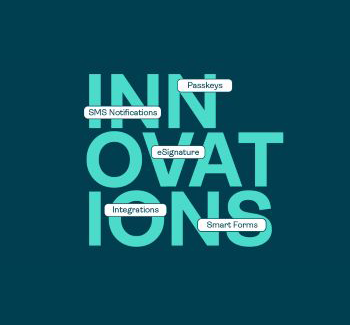Dispelling the UK's Five Most Common Electronic Signature Myths

The shift towards remote agreements in financial services and insurance has been developing for several years. With the rise of digital-only challenger banks and the decline of brick and mortar branches, customers are increasingly favouring providers with remote capabilities. Unsurprisingly, when the pandemic hit, the use of remote agreements exploded across the globe as consumers needed digital access to key services.
By facilitating remote agreements, electronic signature technology has played a key role in ensuring business continuity during the past year. For many organisations the technology has been a lifeline which kept them afloat during difficult times. Moving forward, the sector looks set to continue growing exponentially as more industries and organisations adapt to digital services and agreements. Last year, in light of the pandemic, the FCA reaffirmed in a statement that it did not "explicitly require wet-ink signatures in agreements", providing guidance that electronic signatures were a tool that would enable businesses to continue to operate remotely.
Undoubtedly, organisations and consumers have built such strong habits and familiarity with these digital products and services that it's certain beyond the pandemic e-signatures will become a key cornerstone for a range of businesses. Digital signature laws vary from country to country, but most share the same basic principles around signing documents. Despite this, misconceptions and misinformation about this crucial, but often-overlooked, technology abound. Here are the five most common myths – busted – around electronic signatures in the UK.
1. E-signatures aren't legally valid
False. The United Kingdom has legally recognised e-signatures for almost two decades. The Electronic Signatures Regulations were passed by parliament in 2002, as a result of a 1999 EU Directive. In 2014, these were replaced by EU eIDAS Regulation, which remained part of UK domestic law after Brexit.
However, there are still certain documents that cannot be e-signed, namely those requiring witness attestation or public filing, as well as those where stamping is required. This includes wills, family law documents, corporate accounts, revenue and customs documents, deeds, land registry documents and leases over three years in length.
2. Electronic signatures are not as legally binding as "wet signatures"
This myth has lingered from the initial emergence of e-signature technology and doesn't take into account recent technological advances in tracing and authentication. There are now numerous e-signature products available which lean on a host of technologies to ensure that when you e-sign a document, it's just as legally binding as a traditional signature.
There's also judicial precedent to support the use of digital signatures in the UK. For instance, in 2014, Kathryn Bassano v Alfred Toft determined that a regulated agreement under the Consumer Credit Act 1974 could be signed electronically. This confirmed the liberal approach to what is considered a signature under UK law.
This doesn't, however, mean that any electronic sign-off counts as an e-signature. In 2006, J Pereira Fernandes SA v Mehta determined that the automatic inclusion of the sender's email address after a document has been transmitted does not amount to a signature. In this case, the court reasoned that an automated process generated by an application did not evidence the necessary intention to authenticate the document on behalf of the user.
3. All e-signatures are created equal
In reality, the EU's eIDAS regulation recognises three distinct types of electronic signature, simple, advanced and qualified.
A simple e-signature can be any form of electronic message associated with an individual, including typed signatures and e-mail blocks. In comparison, an advanced e-signature is one that is uniquely associated with an individual and linked to data, so that any subsequent change in the data is readily identifiable.
Finally, a qualified e-signature is generated by a qualified electronic signature creation device and has the same validity as a handwritten signature. Though this is the only type of e-signature with the same status as a handwritten signature under EU regulation, there are no documents that specifically require the use of a qualified electronic signature in the UK.
EU eIDAS regulation stipulates that qualified electronic signature creation devices must be backed by a certificate issued by a qualified trust service provider. Accreditation for trust service providers in the UK is provided by tScheme, a self-regulatory body which maintains the UK's list of trusted services.
4. E-signatures are difficult, or impossible, to trace
Of all e-signature myths, this one is furthest from the truth. Secure electronic signature solutions, such as those accredited by tScheme, authenticate users before they e-sign and tie that authentication to the e-signature and the e-signed record.
The compliance of accredited digital signature solutions is often significantly stronger than a "wet signature", as they provide a complete account of what unfolded during each transaction – who signed, where, in what order, which pages they viewed etc.
When choosing an electronic signature provider, it's important to find a solution that supports multiple authentication methods and has the flexibility to configure them in the same transaction, while fitting the risk profile of your business.
5. E-signatures are a pain for auditors
In this case, the opposite is true. E-signatures can actually help regulated companies prove to auditors that they accurately followed a particular business process. With more sophisticated electronic signature solutions, businesses can provide auditors with a record of every time key documents were touched, when, and by whom.
For example, electronic signature solutions can now provide both document and process audit trails for the purpose of demonstrating compliance to auditors. To facilitate sharing with internal and external parties, self-contained audit trail packages can be exported for more efficient and transparent records management. This allows employees and auditors to view a comprehensive audit trail to determine exactly when and how a transaction took place and by whom – something that isn't possible with paper documents.
In years to come, consumers will continue to drive different industries forward, showing a demand for more remote services and capabilities. Over the past year, even consumers who haven't previously been so digitally native have become much more familiar with these services.
So, with these myths firmly dispelled, it's clear that adopting e-signature technology can help businesses retain customers and get ahead of the competition – especially as widespread remote working continues. E-signatures don't only bring speed and simplicity to agreements. They also offer transparency, a greater level of security and an improved customer experience.
This blog, written by Sameer Hajarnis, Regional Vice President of Sales, was first published in GlobalBankingandFinance.com on 5 April 2021.









